9 Ways Companies Can Reduce Food Packaging Waste
By: phase1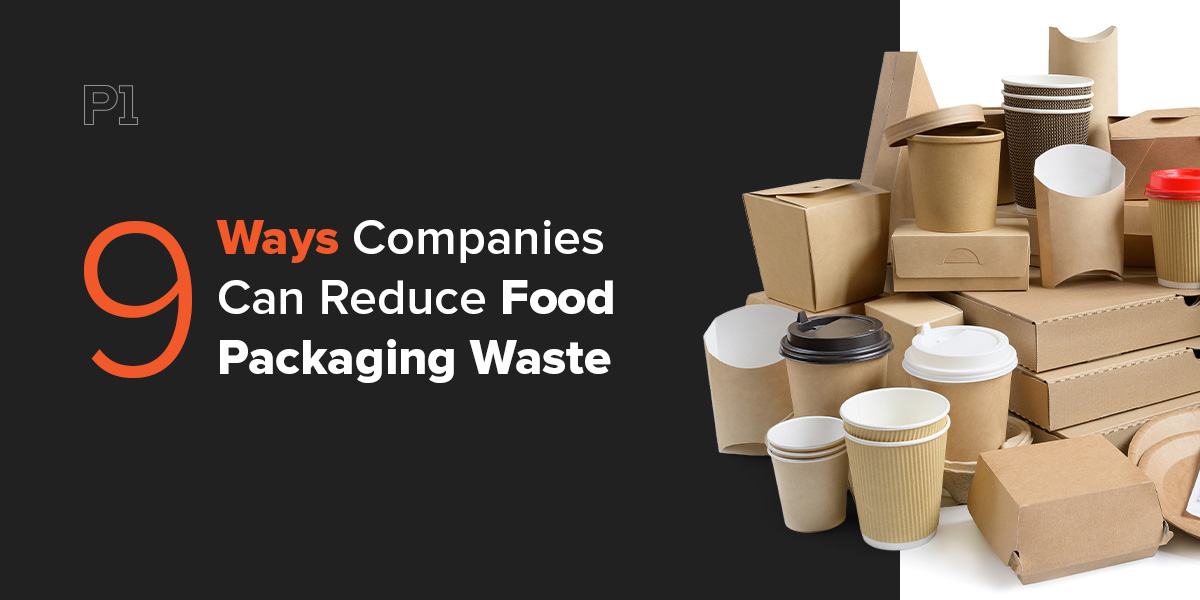
If you manage a company in the food or retail industry, you have many potential reasons to limit the amount of waste your employees and customers must dispose of. You can save money as you reduce food packaging waste, but you can also appeal to customers by striving for a high standard of sustainability. Keep reading to learn how to reduce food packaging waste and use innovative food packaging to improve your financial goals.
Types of Food Packaging Waste
Different types of packaging materials are often layered together or used in combination to preserve the quality and freshness of the contained goods. Some materials are better for promoting sustainability than others. In the past, companies have focused on using the materials with the highest convenience factor and lowest associated costs.
The type of packaging you use for a product might depend upon the sourcing location, consumption timeline and intended use of the packaging itself. These factors and many others contribute to how food is stored or sold. Below are some types of food packaging waste that result from common containment methods:
1. Paperboard Waste
Paper waste is usually layered to make the packaging stronger and more durable. Paperboard might be used to make bags, product boxes and other items. Although paper packaging is better for the environment than waste that can’t decompose, it is often made with a layer of plastic that causes the paperboard to break down much more slowly.
2. Metal Waste
The metal components of food packaging are often a small part of the leftover materials that end up in landfills. However, some types of packaging are nearly entirely metal with a plastic or paperboard casing to display product information. Empty cans and tins are common types of metal waste.
3. Plastic Waste
Plastic is highly flexible in its design capabilities, which is what has made it a popular replacement for earlier methods of glass and porcelain packaging. It is still used to make disposable containers, disposable cutlery, bags, straws, freshness seals, tamper-proof packaging and many more components of food packaging.
Plastic presents several issues with disposal after it extends its usefulness. New types of plastic are recyclable or reusable, keeping this material out of the trash, but customers must complete the recycling process.
4. Foam Waste
Plastic foam is used for disposable food containers and insulated packaging. Because of its insulation property, it can also be used to construct disposable coolers for perishable, temperature-sensitive goods transported over long distances to customers. Plastic foam containers are popular for food items that can be prepared and heated quickly.
Although plastic foam is a useful packaging material, it takes even longer to decompose than other plastic waste — if it decomposes at all. Traditional foam packaging is made of polystyrene, which is made without an eco-friendly manufacturing process and results in hazardous waste in its formation. Plastic foam can also seep into water supplies, unable to break down.
How Food Packaging Waste Harms the Environment
The major concern with single-use packaging designed to be thrown away is that it will remain in landfills for many years. The amount of waste has gradually accumulated to high numbers that have a serious impact on the environment at large. Possible solutions are sustainable packaging that can be reusable, recyclable or compostable, but most food packaging is single-use and makes up a large portion of municipal solid waste.
Packaging waste for food and other products brings harm to these aspects of the environment:
1. The Land
The majority of plastic packaging is unable to decompose as quickly as organic materials and has the potential to sit in landfills for up to 200 years or longer. Packaging with the longest lifespans includes grocery bags, plastic drink bottles and containers, drink holders, plastic wrap, plastic seals, coffee cups with plastic linings and straws.
2. Wildlife
Food packaging is especially threatening to the marine environment and wildlife because it clogs waterways and accumulates in the oceans. Marine animals often consume discarded plastics or get trapped in them, which is why reducing the amount of food packaging waste could have a significantly positive impact on these animals.
According to the Ocean Conservancy, plastic wastes have been discovered in the stomach contents of over half of all sea birds tested, in all of the turtle species and in about a quarter of fish from seafood markets.
3. The Oceans
Much of the plastic has settled on the ocean floor, where fish feed on microplastics and are then caught for our consumption. Over a relatively brief period in human history, solid waste has accumulated into large, floating islands made of garbage, and there are now initiatives to clean the oceans aiming to change the way packaging is made and used.
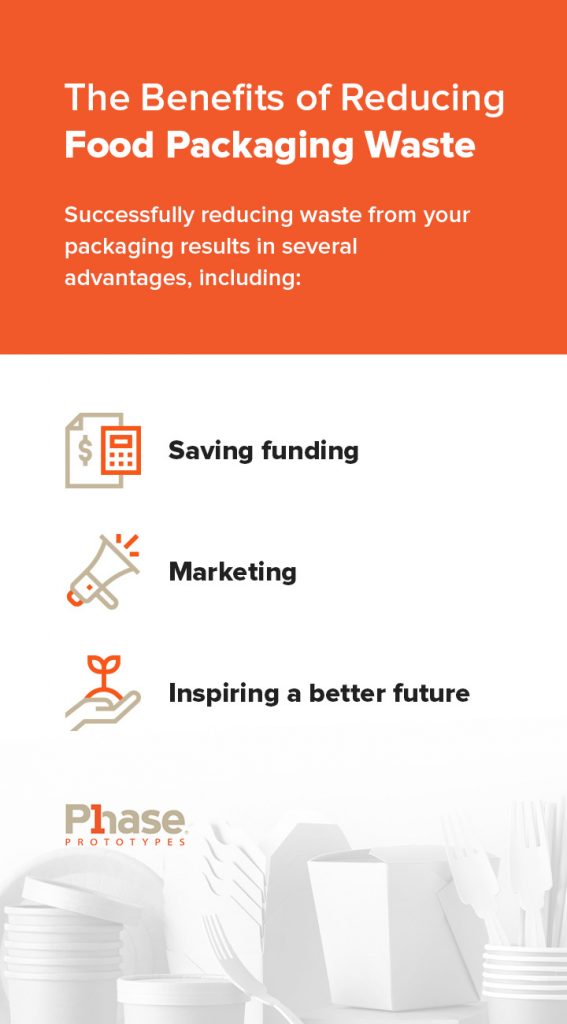
The Benefits of Reducing Food Packaging Waste
You can reduce your waste in many ways, and each strategy comes with its own benefits. Generally, reducing your food packaging waste is a positive move for companies looking to improve their sales models. Successfully reducing waste from your packaging results in several advantages, including:
- Saving funding: Lower costs are associated with reducing packaging materials. This applies to preparing your products for transit or store shelves.
- Marketing: Engaging in ethical packaging practices makes your company attractive to customers.
- Inspiring a better future: As more companies strive for sustainability, reducing waste from all kinds of product sales is becoming more common.
Ways to Reduce Food Packaging Waste
If your company is looking for ways to reduce product waste and enhance your sustainability, you can take several actions to put your product packaging closer to achieving this goal. Many of these solutions are more affordable than traditional methods of commercial food packaging. You can limit the amount of food packaging your customers have to dispose of by following these practices:
1. Reduce The Ammount Of Packaging
Limit waste that ends up in landfills by using less packaging materials so your customers will have less to throw away. You can also cut spending on packaging if you carefully limit the materials you contain your products in. Investing in minimalistic packaging has many other benefits, including:
- Product packaging will be lighter in weight and easier to transport.
- Minimalistic custom packaging can be attractive to customers and effectively market your products.
- It takes less energy to manufacture slim, minimalistic packaging, and fuel-related transportation costs are less.
- Less packaging is convenient for customers to dispose of, whether the packaging is recyclable or not.
2. Use Recyclable Food Packaging
Reusable materials offer another solution for limiting the overall amount of food packaging in circulation. Cardboard boxes and paper products can be converted into new packaging for the same type of products or another packaging purpose. Although recycling plastic is a more difficult process, recyclable plastic packaging has gained popularity in recent years. Everything from recyclable grocery bags to product sleeves can be taken to a plastic recycling facility.
Some of the benefits of using recyclable packaging include:
- Continued use of old materials: Reusing materials like plastic allows you to enjoy their benefits, keep them in circulation and use your packaging ethically.
- Lower sourcing costs: Recyclable packaging results in lower costs for new packaging materials, with the simple cost of manufacturing new packaging from old materials.
- More options: Food packaging that can be recycled gives you more options than switching to another material or limiting the amount of materials you can use for your products.
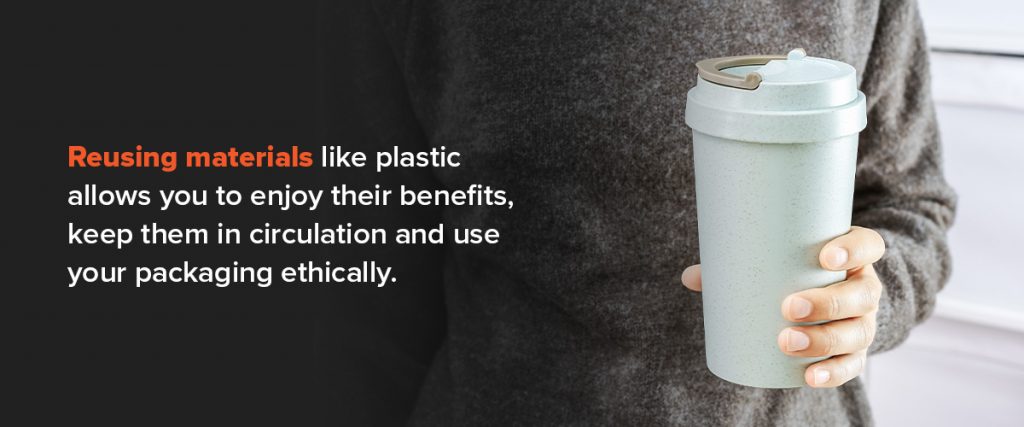
3. Invest In The Right Training
Following eco-friendly business practices can help reduce waste nearly as much as selecting sustainable product packaging. Employees improperly disposing of food packaging waste and other materials can also have a negative impact. Make your team aware of preferable waste disposal methods so you can continue to adapt as an environmentally conscious company.
Training should include methods for reducing packaging and manufacturing waste because you can make the biggest difference by focusing on both. Train employees in these areas to help your organization the most:
- Basic disposal policies and procedures: Make them aware of your recycling policies, where to find the appropriate disposal bins and how often they should use the disposal bins.
- Environmentally conscious practices: Teach employees about the value of eco-friendly practices with workshops and educational videos. If your employees understand the importance of your company’s policies, they will be more likely to participate.
- Company rules and regulations: Inform all new employees about rules related to your disposal practices and remind all employees when a rule is accidentally violated.
4. consider Using A Cardboard Baler
Cardboard is a versatile packaging material used in every facet of the food industry. Investing in a baler can help compress your company’s cardboard waste into a more manageable surface area. Bales of cardboard are easier to recycle with each individual scrap combined.
If your company accumulates a significant amount of cardboard waste from products, daily operations or manufacturing practices, you would benefit from getting a baler because of:
- The superior storage options: You can greatly reduce the storage space these materials take up by baling them.
- Reduced costs: Compressing cardboard can lower the volume of waste so much that it will reduce your collection costs.
- Lighter, more compact transportation: Baled cardboard is easier to transport and manage.
5. Try Biodegradable Packaging
Biodegradable packaging can be composted or disposed of without concern that it will clog up landfills for years. This type of packaging is made from sturdy materials that decompose. The packaging is often a more environmentally friendly variation of older material.
Corn-based plastics break down easily while offering many of the same advantages that made earlier forms of plastic so popular as food packaging materials. Another solution is water-soluble packaging materials that the customer can dispose of. Most biodegradable packaging materials must be taken to commercial composting facilities to continue their lifecycle.
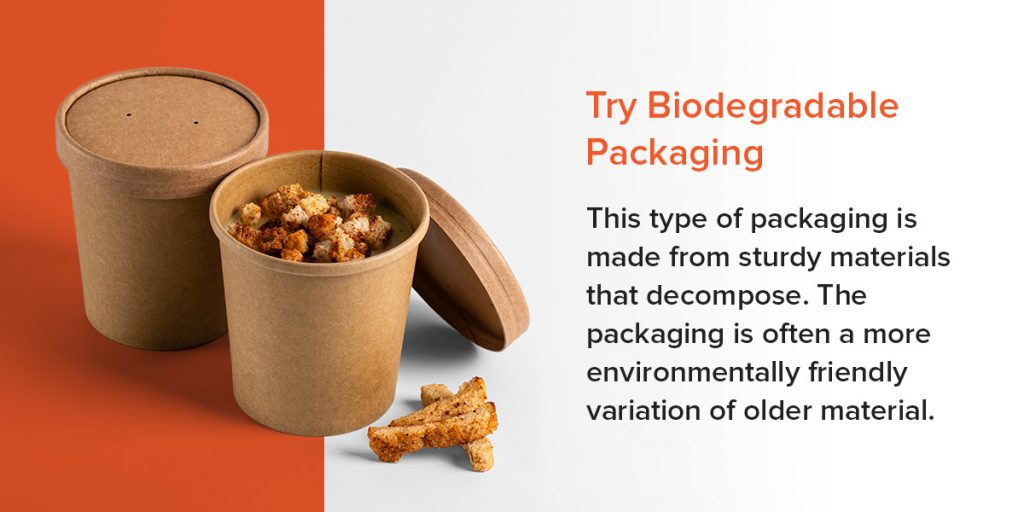
6. Implement Reuseable Packaging
Reusable packaging is also called returnable transport packaging (RTP). These containers are more durable than disposable alternatives and can be used at least twice. Many forms of reusable packaging can be used multiple times.
If your product packaging is reusable instead of disposable, customers will have more opportunities to use it again without taking steps toward a recycling process. Reusable food packaging can be as simple as branded bags that you ask customers to buy with their purchases to reuse when returning for more products. Reusable product packaging is often slightly more expensive to produce than disposable items, but the expense depends on the materials used.
Many traditional forms of packaging have the potential to be reused when customers know how to repurpose these items. Other examples of RTP include:
- Pallets
- Shipping racks
- Carton boxes
7. Use Sustainable Raw Materials
Sustainable raw materials are another possible replacement for older methods of packaging. Packaging made from these materials can be as durable as other options like plastic and is often of a higher quality. When using raw materials, you can get innovative in your product presentation and inspire your customers to enjoy the packaging almost as much as the goods that come in them.
Raw materials that can benefit your company include:
- Wood sourced from sustainable tree farms, which can be used to manufacture cardboard or paper packaging.
- Cotton, which is used to make tote bags and other high-quality packaging.
- Sustainable synthetic fibers that are specially designed to be eco-friendly.
8. Use An Industrial Shredder
Investing in a shredder can help you dispose of any fiber materials, including food packaging made from paper and cardboard. This is another reason using cardboard for your packaging is a good choice. Beyond disposal, shredders also make it possible to harvest your own packing to fill your shipping boxes.
Shredded paper is eco-friendly and lightweight, making it a valuable shipping material. Paper cushions and protects your products. Shredded paper is also easier to recycle than whole paper waste.
9. Spread Awareness
Part of the reason you may want to limit your packaging or switch to a more eco-friendly material is that you care about your customers and how they view your products. If you encourage your customers to use your recycling options, you will achieve the best possible results when implementing your new program. Written guidance on your packaging can inform your customers how the recycling process works or how to dispose of the packaging properly.
You can promote sustainability by making customers aware of the efforts you have taken toward sustainability. You can also use sustainable or minimalistic packaging as a marketing tool. Show your customers that your competitors tend to overuse packaging, making your goods look fresher and more appealing.
Partner With Phase 1 Prototypes
We produce custom food and beverage packaging to impress your customers and meet your specifications. At Phase 1, our packaging is designed for convenience and ease of use with plenty of sustainable options. Contact us if you have questions about our manufacturing services.

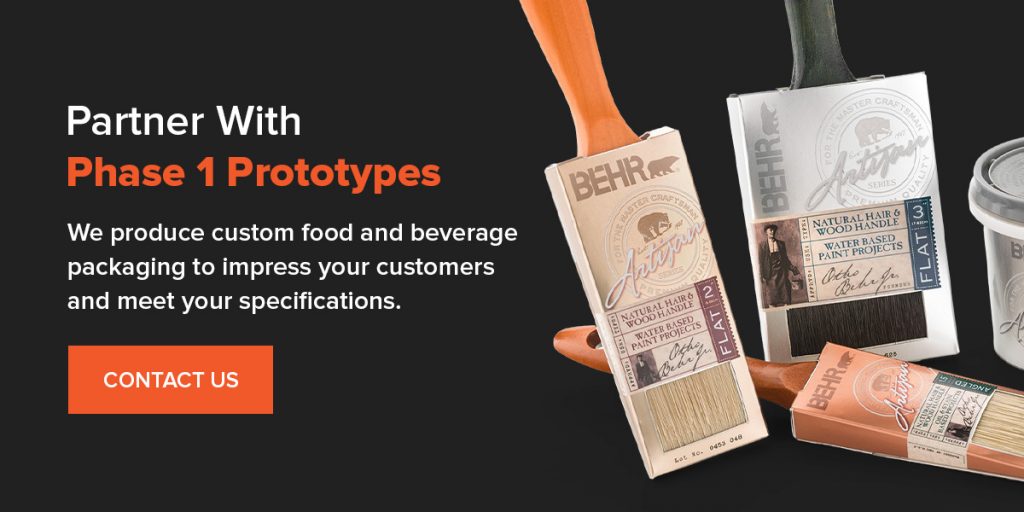
Leave a Reply